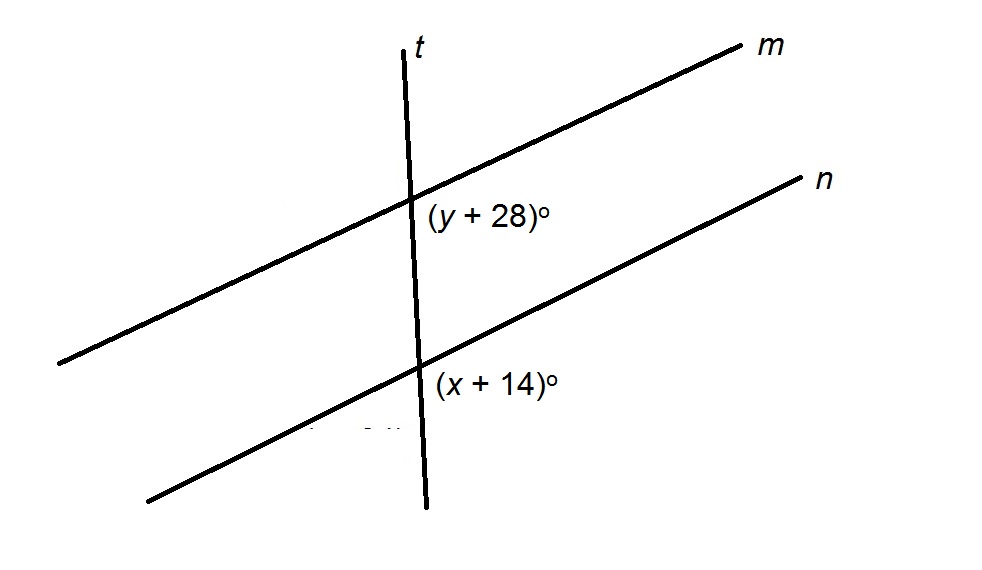All SSAT Upper Level Math Resources
Example Questions
Example Question #5 : Properties Of Parallel And Perpendicular Lines

Figure NOT drawn to scale
In the above figure, 


The two marked angles are corresponding angles of two parallel lines formed by a transversal, so the angles are congruent. Therefore,
Solving for 
Example Question #6 : Properties Of Parallel And Perpendicular Lines

Figure NOT drawn to scale
In the above figure, 

The two marked angles are same-side exterior angles of two parallel lines formed by a transversal 
Example Question #651 : Ssat Upper Level Quantitative (Math)
Three lines are drawn on the coordinate plane.
The green line has slope 


The blue line has slope 


The red line has slope 


Which two lines are perpendicular to each other?
It cannot be determined from the information given.
No two of these lines are perpendicular.
The blue line and the green line are perpendicular.
The green line and the red line are perpendicular.
The blue line and the red line are perpendicular.
The blue line and the red line are perpendicular.
To demonstrate two perpendicular lines, multiply their slopes; if their product is 

The products of these lines are given here.
Blue and green lines:
Red and green lines:
Blue and red lines:
It is the blue and red lines that are perpendicular.
We can also see that their slopes are negative reciprocals, indicating perpendicular lines.
Example Question #651 : Ssat Upper Level Quantitative (Math)
Two perpendicular lines intersect at point 

Insufficient information is given to answer the question.
The slopes of two perpendicular lines are the opposites of each other's reciprocals.
To find the slope of the first line substitute 
The slope of the first line is 

Example Question #652 : Ssat Upper Level Quantitative (Math)
Two perpendicular lines intersect at the origin; one line also passes through point 
Insufficient information is given to solve the problem.
The slopes of two perpendicular lines are the opposites of each other's reciprocals.
To find the slope of the first line, substitute 
The slope of the first line is 

Example Question #654 : Ssat Upper Level Quantitative (Math)
Which of the following lines is perpendicular to the line 
All we care about for this problem is the slopes of the lines...the x- and y-intercepts are irrelevant.
Remember that the slopes of perpendicular lines are opposite reciprocals. By putting the given equation into 


The equation 

Example Question #653 : Ssat Upper Level Quantitative (Math)
Line A passes through the origin and 
Line B passes through the origin and 
Line C passes through the origin and 
Line D passes through the origin and 
Line E passes through the origin and 
Which line is perpendicular to Line A?
Line E
Line D
None of the other lines is perpendicular to A.
Line B
Line C
Line D
Find the slopes of all five lines using the slope formula 
using the other point.
Line A:
The correct line must have as its slope the opposite of the reciprocal of this, which is 
Line B:
Line C:
Line D:
Line E:
Of the last four lines, only Line D has the desired slope.
Example Question #435 : Geometry
Line W passes through the origin and point 
Line X passes through the origin and point 
Line Y passes through the origin and point 
Line Z passes through the origin and point 
Which of these lines is perpendicular to the line of the equation 
Line W
Line Z
Line Y
Line X
None of the other responses is correct.
Line Z
First, find the slope of the line of the equation 
The slope of this line is 

Find the slopes of all four lines by using the slope formula 
using the other point.
Line W:
Line X:
Line Y:
Line Z:
Line Z has the desired slope and is the correct choice.
Example Question #436 : Geometry
Determine whether the two equations are parallel, perpendicular or neither, and choose the best reason.
Perpendicular, the slopes are the same.
Neither, the slopes have no correlation.
Perpendicular, the slopes are the negative reciprocal to each other.
Parallel, the slopes are the same.
Parallel, the slopes are the negative reciprocal to each other.
Neither, the slopes have no correlation.
Convert both equations to slope intercept form:
The slope of the first equation is 
Convert the second equation.
The slope of this equation is zero since there is no 
In order for the two functions to be parallel, they must have the same slopes.
In order for the two functions to be perpendicular, their slopes must be the negative reciprocal to each other.
Since there's no correlation with both slopes, the equations are neither parallel or perpendicular to each other.
The correct answer is:
Neither, the slopes have no correlation
Example Question #13 : Properties Of Parallel And Perpendicular Lines
Given: the following three lines on the coordinate plane:
Line 1: The line of the equation
Line 2: The line of the equation
Line 3: The line of the equation
Which of the following is a true statement?
Line 1 and Line 2 are perpendicular; Line 3 is perpendicular to neither.
Line 2 and Line 3 are perpendicular; Line 1 is perpendicular to neither.
No two of Line 1, Line 2, or Line 3 form a pair of perpendicular lines.
None of the other responses is correct.
Line 1 and Line 3 are perpendicular; Line 2 is perpendicular to neither.
Line 1 and Line 2 are perpendicular; Line 3 is perpendicular to neither.
Line 1, the line of the equation 

The slope of Line 3, the line of the equation 
The slope is 

Correct response: Line 1 and Line 2 are perpendicular; Line 3 is perpendicular to neither.
All SSAT Upper Level Math Resources




































































